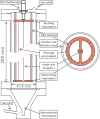Novel concept for neutron detection: proportional counter filled with 10B nanoparticle aerosol
- PMID: 28181520
- PMCID: PMC5299432
- DOI: 10.1038/srep41699
Novel concept for neutron detection: proportional counter filled with 10B nanoparticle aerosol
Erratum in
-
Corrigendum: Novel concept for neutron detection: proportional counter filled with 10B nanoparticle aerosol.Sci Rep. 2018 Feb 12;8:46942. doi: 10.1038/srep46942. Sci Rep. 2018. PMID: 29430010 Free PMC article.
Abstract
The high neutron detection efficiency, good gamma-ray discrimination and non-toxicity of 3He made of proportional counters filled with this gas the obvious choice for neutron detection, particularly in radiation portal monitors (RPM), used to control the illicit transport of nuclear material, of which neutron detectors are key components. 3He is very rare and during the last decade this gas has become increasingly difficult to acquire. With the exception of BF3, which is toxic, no other gas can be used for neutron detection in proportional counters. We present an alternative where the 3He atoms are replaced by nanoparticles made of another neutron sensitive material, 10B. The particles are dispersed in a gaseous volume, forming an aerosol with neutron sensitive properties. A proportional counter filled with such aerosol was exposed to a thermal neutron beam and the recorded response indicates that the neutrons have interacted with the particles in the aerosol. This original technique, which transforms a standard proportional gas mixture into a neutron sensitive aerosol, is a breakthrough in the field of radiation detection and has the potential to become an alternative to the use of 3He in proportional counters.
Conflict of interest statement
The authors declare no competing financial interests.
Figures





References
-
- U.S. House of Representatives Committee on Science & Technology. Caught by surprise: causes and consequences of the helium-3 supply crisis. Hearing Charter https://www.gpo.gov/fdsys/pkg/CHRG-111hhrg57170/html/CHRG-111hhrg57170.htm (Date of access: 03/12/2016) (2010).
-
- United States Government Accountability Office. Neutron detectors alternatives to using helium-3. Report to Congressional Requesters http://gao.gov/assets/590/585514.pdf (Date of access: 03/12/2016) (2011).
-
- Kouzes R. T. The 3He supply problem. Pacific Northwest National Laboratory http://www.pnl.gov/main/publications/external/technical_reports/PNNL-183... (Date of access: 03/12/2016) (2009).
-
- Sacchetti F. et al.. He-free neutron detectors and their applications. Eur. Phys. J. Plus 130, 53 (2015).
-
- Mazed D., Mameri S. & Ciolini R. Design parameters and technology optimization of 3He-filled proportional counters for thermal neutron detection and spectrometry applications. Radiation Measurements 47, 577–587 (2012).
Publication types
LinkOut - more resources
Full Text Sources
Other Literature Sources
Miscellaneous

